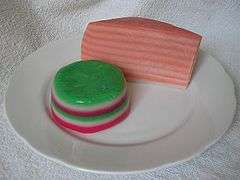Nine auspicious Thai desserts

The nine auspicious Thai desserts are one of Thailand's culinary treasures. They are served on special occasions such as weddings, housewarmings, or ordinations. They confer blessings on the recipient.[1] To deliver all the blessings at one time, the nine desserts are offered together on one tray.
Thong yot
Thong yot is described as a sister of thong yip, due to the similarity in ingredients even though the form is different. Thong yod means "golden drop". It augurs wealth for the person who is served it.[2]
Foi thong
Foi thong uses the same ingredients as thong yip and thong yod. Foi thong means "golden noodle" or "golden yarn". It bestows long lasting love and life. Mostly it is used in Thai wedding ceremonies to bless the bride and groom.[3]
Thong ek
Thong ek is made of the same ingredients as foi thong, carved in the shape of a flower. It is said to be the most difficult and beautiful dessert of the thong desserts. Thong ek means "the one and only", "tops", "the best". It is conveys a blessing for a fruitful career.[3]
Met khanun
Met khanun is made from mashed green bean coated with egg yolks. The name med khanun comes from its shape, which looks like jackfruit (khanun) seed (med). It symbolizes the support one will receive in one's career and in life.[3]
Cha mongkut
There is confusion between cha mongkut and dara thong. Cha mongkut is the name of a dessert made from incense-scented flour, bean flour, sugar, coconut milk, and roasted watermelon seed which looks like "kalamae" invented 200 years ago in the era of King Rama II. Dara thong is a crown-like dessert made of flour, egg yolk, sugar, gold leaf, roasted watermelon seeds, and jasmine-scented water, invented by Dame Jue Nakornrachaseni around 1938.[4] Ja mongkut means the "owner of the crown", the top position.[3]
Khanom sane chan
The ingredients of khanom sane chan are two kinds of flour, eggs, coconut milk, sugar, and nutmeg. Named after a fruit called "luk chan" which has good looking form and great odor. Saneh chan means "charming Chan". It assures the receiver of love, adoration, and charm, mostly used in wedding ceremonies.[5]
Khanom chan

Khanom chan consists of tapioca flour, rice flour, arrowroot flour, coconut milk, sugar, and jasmine-scented water. In the past it was arranged into a rose shape, but the most common shape is stacking each layer together into nine layers. Kanom chan literally means "layered dessert". It symbolizes success and advancement.[6]
Thuai fu
Thuai fu is made of flour, sugar, yeast, and jasmine-scented water. Thuai fu is named after its shape. Its meaning is "rising bowl" which symbolizes improvement in life and career[7]
See also
References
- ↑ "Thai Desserts: Auspicious Desserts". Ramkhamhang Newspaper. March 15, 2004. p. 4.
- ↑ "9 Auspicious Thai Desserts". Learn Thai With Mod. 18 September 2013. Retrieved March 9, 2016.
- 1 2 3 4 "Thai 9 Auspicious Desserts". thaidesserts0205.blogspot.com. 2 May 2012. Retrieved 2016-03-09.
- ↑ "Dara Thong and Mongkut Petch". pantip.com. July 17, 2013. Retrieved March 9, 2016.
- ↑ Navakaew, Kannikar. "Khanom Saneh Chan". pirun.ku.ac.th. Retrieved March 9, 2016.
- ↑ Chumkum, Chaowalee (August 2, 2015). "Rose Shape Khanom Chan". Retrieved March 9, 2016 – via Dailynews.
- ↑ Navakaew, Kannikar. "Khanom Thui Fu". pirun.ku.ac.th. Retrieved March 9, 2016.
